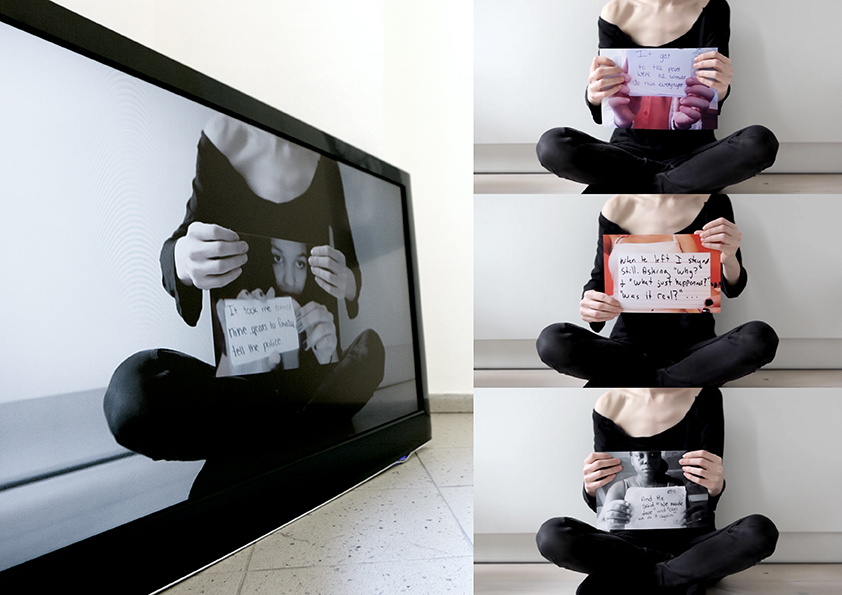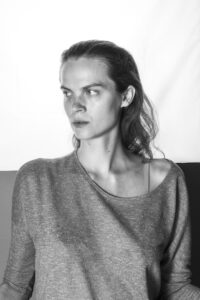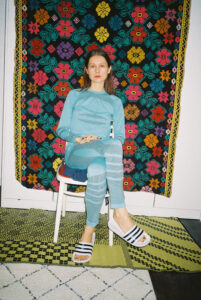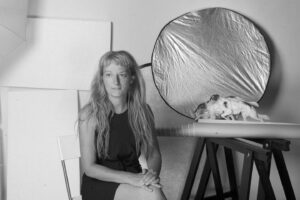Alma Lily Rayner

– born in 1984 in Israel, based in Czech Republic, artist and activist. In her practice she achieves uncompromising vivisections of public discourses. For years she has continuously been exploring themes of rape, trauma, and deconstructing invisible, secret forms of symbolic violence. Rayner is interested in gender inequality and the relationship with power structure organizing modern society. She sees sexualized violence as one of the most severe symptoms of this imbalance. The artist proves that the concept of rape and its semantic field does not close within clishés and popular notion of degenerate and brutal men who lurk underground subways armed with knives. Day-to-day men also commit rape: friends, family members, people who are appreciated and admired.
Rayner grew up in Israel and attended the theatrical class in high school. During Bible study class (mandatory in Israel), she directed a play in which God-Woman climaxes after realizing the magnificence of the world she created (after this blissful moment she dies of effort). As a teenager she was interested in art that relates to constant search for autonomous space in a country constantly entangled in war. The art scene allowed for more free political discussions, which reached beyond the framework of nationalist narration of the mainstream. Art carried a promise for dialogue on important issues and constituted an attempt to bring social change.
At the age of 19, Rayner moved to Prague where she graduated from the Fine Arts Academy. She also studied at FAMU and UMPRUM. In 2019 she was one of the finalists of the renowned Chalupecky competition. Rayner uses various digital media: photo collages, video, 3D visualizations. The creation of relationships with people through discussion panels or through co-authored horizontal educational structures of Barvolam is very crucial for her practice. “Survival Manual” (2020), project realized in PLATO, Ostrava (finalists’ exhibition of the Chalupecky competition) is an example of artistic gesture with political influence1.
It aims at creating safe space for people who experience forms of oppression. The platform is created together with experts by experience and other activists and serves for support, debate and sharing one’s experiences and emotions. Throughout the duration of the exhibition a series of events was planned by experts by experience. The meetings were completed by other help strategies: like a participatory library and a work group meeting regularly.
The critique of institutionalized help, which is limited to its form, becomes supplemented with alternative methods of support. Gallery space becomes a place for experience exchange, radical care space, where attention is directed towards creation of knowledge, cooperation and mutual support.
The main axis of Rayner’s work is her own story. However, at the same time the artist conducts long-term research on the subject of rape culture in a broader sociological context, thus creating a more universal narrative of what violence really is.
“It is a silent war, an invisible one. There are no explosions. No armies gushing.
No cameras sniffing.
Whatever happens there, no nation will stand still. The battlefield is just a house. The bed is neat and pink.
A spoon, a toy, a piece of soap. He is just a father. She is just a daughter. Another year has passed.”2
One of such actions was the auto-biographical project with a telling title “Some Things My Father Put Inside My Vagina”. The viewer can see everyday items created with a 3D printer34. The objects are harmless, tamed, they do not raise suspicions: spoon, marker pen, plastic toy, lighter or a bar of soap. The prints of the 3D models were presented in Art Wall Gallery in Prague, which utilizes billboards along a busy transit route. The pictures resemble advertisements of beautiful, ceramic objects.
The goal of this exhibition was to start a public discourse on rape culture. The project was supplemented with a series of discussion panels, which were conducted by the artist. The main problems revolving around the culture of rape were revealed in the panel titles: What did you expect?, Why didn’t you report it?, Why didn’t you fight back?, while the panelists consisted of representatives of activists, researchers, non-profit sector employees and survivors of sexualized violence. During the meetings, several aspects of rape culture were discussed, as well as institutions that regularly deal with this problem, e.g. the police. “Why Didn’t You Say Something? An evening of sharing.” was the title of the final meeting. It was open to anyone willing to share their stories of violence – sexualized violence. Feminist methodology was applied during the discussions, aiming at extracting subjectivity of participants.
“Feminism is a form of therapy. Feminism saved my life, gave me categories, in which I can process what happened. I know that it is power, not sex that drives sexual violence. Sexual violence is embedded in a systemic gender inequality in a society. The term “rape culture” allows us to capture it.”5
Would you like a Cookie? (2016) is a video performance, where 11 young women read collective confession6. After living through sexual abuse, they share their stories publicly in social media. The artist studies and uses fragments of their statements, at the same time analyzing the socio-cultural narrative that emerges through the language. An example of a recurring approach is the way they reduce the rapist to calling him a “him” (instead of “father”, “brother”, “partner”), hence leaving the pronoun as the only male aspect of the rapist’s identity. The details, numbers, statistics are often stated to better organize chaotic reality in a therapeutic attempt to conjure reality.
The language layer is very important in Rayner’s practice. She notices who, why and how they talk about violence as she recognizes it is crucial when discussing trauma. She uses the word “survivor” instead of “victim” to emphasize the strength of a person, who suffered sexual exploitation. The act of public speaking out of “survivors” has ritual, therapeutic and political dimensions. Women regain control over their experiences, creating their images using their own voice. Coming out demonstrates that it not only is a problem of a woman, but the society as a whole.
Text written by Jolanta Nowaczyk based on interview with Alma Lily Rayner (2020).
1Image: Alma Lily Rayner, Návod na přežití, 2020, installation view, PLATO Ostrava. Courtesy of the artist.2Alma Lily Rayner, Some Things My Father Put Inside, see: https://www.almalilyrayner.com/some-things-my-father-put-inside.
3Image: Alma Lily Rayner, Some Things My Father Put Inside My Vagina, 2017, installation view, ArtWall Prague. Courtesy of the artist.
4Image: Alma Lily Rayner, Some Things My Father Put Inside My Vagina, 2017, installation view, ArtWall Prague. Courtesy of the artist.
5Apolena Rychlíková, Some Things My Father Put Inside. Alma Lily Rayner in Studio A2larm, 2017, interview with Alma Lily Rayner, see: https://youtu.be/uMQgueEm7zs.
6Image: Alma Lily Rayner, Would you like a Cookie?, 2016, video still. Courtesy of the artist.
– narozena 1984, umělkyně a aktivistka narozena v Izraeli a působící v Praze, absolventka Akademie výtvarných umění v Praze a filmové školy FAMU. Finalistka Ceny Jindřicha Chalupeckého v roce 2019, v jejímž rámci připravila projekt „Surviving Gudie“ v galerii PLATO v Ostravě.
Izraelsko-česká umělkyně a aktivistka Alma Lily Rayner ve své tvorbě provádí nekompromisní vivisekci veřejných diskursů. Nepřetržitě již několik let zkoumá téma násilí, traumatu a dekonstruuje neviditelné, utajené formy symbolického násilí. Rayner zajímají genderové nerovnosti a mocenské vztahy organizující současnou společnost, přičemž znásilnění chápe jako jeden z důležitějších symptomů této nerovnováhy. Umělkyně dokazuje, že pojetí sexuální násilí i jeho významové pole není jen otázkou klišé a rozšířených představ o zdegenerovaných brutálních mužích, kteří číhají s nožem v temných podchodech. Aktéry znásilnění jsou přitom muži kolem nás – naši přátelé, členové rodin, osoby ceněné a obdivované.
Rayner vyrůstala v Izraeli a na gymnáziu chodila do divadelní třídy. V rámci v Izraeli povinného studia Bible režírovala hru, v níž Bůh-žena prožívá orgasmus poté, co zjišťuje, jak úžasný je svět, který stvořila (a po tak silné rozkoši umírá vyčerpáním). Jako teenagerka se zajímala o umění hledající autonomní oblast v zemi, která je neustále ve válečném stavu. Navíc v uměleckých kruzích panovala větší svoboda politických diskusí mimo těsné nacionalistické narace hlavního proudu. Umění neslo příslib dialogu v důležitých otázkách a představovalo pokus jak aktivovat společenské změny.
V 19 letech se přestěhovala do Prahy, kde vystudovala Akademii výtvarných umění. Studovala také FAMU a UMPRUM. V roce 2019 se stala finalistkou Ceny Jindřicha Chalupeckého. Rayner využívá různá digitální média – fotokoláže, video, 3D vizualizace. V její tvorbě je zásadní tvoření vztahů mezi lidmi pomocí diskusních panelů nebo pomocí horizontální vzdělávací struktury Barvolam.
Příkladem uměleckého gesta s politickou vahou je procesuální a participativní projekt nazvaný „Návod na přežití“ (2020) v rámci výstavy finalistů Ceny Jindřicha Chalupeckého v PLATO v Ostravě1. Jeho cílem je vytvoření safe space pro osoby, které se staly terčem násilí.
Platforma má pomoci při podpoře, diskusi, sdílení emocí a je tvořená společně skupinou ostravských aktivistek a aktivistů, non-profit organizací a zástupců etnických menšin. V průběhu trvání výstavy se uskuteční série akcí spolutvořených experts by experience. Setkání doplním pomocné strategie: kolektivní čtení, spolutvoření knihovny, celodenní setkání s podporou pracovní skupiny a trávení noci v galerii.
Kritika institucionálně zorganizované pomoci, která je nutně omezená, doplňuje hledání alternativních způsobů podpory. Prostor galerie se stává místem výměny zkušeností, místem radical care, kde se vektor pozornosti soustředí na poznávání, spolupráci a vzájemnou podporu. Hlavní osou Raynerové prací je její vlastní příběh. Zároveň ale umělkyně stále provádí dlouhodobý výzkum tématu kultury znásilnění v sociologickém kontextu a tvoří tak univerzálnější příběh toho, čím je násilí.
“It is a silent war, an invisible one. There are no explosions. No armies gushing.
No cameras sniffing.
Whatever happens there, no nation will stand still. The battlefield is just a house.
The bed is neat and pink.
A spoon, a toy, a piece of soap. He is just a father. She is just a daughter. Another year has passed.”2
Jednou z takových akcí byl projekt s výmluvným názvem Some Things My Father Put Inside My Vagina, který je autobiografickým příběhem34. Vidíme předměty každodenního užitku vyrobené technikou 3D. Jsou to věci běžné, nijak děsivé, ale budící podezření: lžička, fix, dětská hračka, zapalovač nebo mýdlo. Velkoformátové fotografie 3D modelů, které téměř připomínají reklamu na hezké keramické předměty, visely na veřejném prostranství – v galerii Art Wall v Praze využívající billboardy podél exponované komunikační trasy.
Cílem této výstavy bylo otevřít veřejnou diskusi o kultury znásilnění. Projekt byl doplněn cyklem diskusních panelů, které umělkyně spoluuváděla. Poukázaly na hlavní problémy spojené s kulturou znásilnění, nadnesené v názvech setkání: What did you expect?, Why didn’t you report it?, Why didn’t you fight back? Pozváni byli aktivisté, výzkumníci, zástupci neziskových organizací a lidé, kteří přežili sexualini násilí. Během setkání byly diskutovány otázky spojené s kulturní podobou znásilnění nebo institucemi věnujícími se tomuto problému, např. policií. Cyklus setkání byl zakončen panelem nazvaným Why Didn’t You Say Something? An evening of sharing. Setkání bylo otevřené pro všechny, kteří by se chtěli podělit o své příběhy spojené s násilím – sexuálním. Podstatnou charakteristikou těchto diskusních panelů byla práce respektující feministickou metodologii, zohlednění osobnosti všech, kteří se jich účastnili.
„Feminismus je forma terapie. Feminismus mi zachránil život a dal mi určité kategorie, v nichž mohu vůbec přemýšlet o tom, co se stalo. Vím, že v sexuálním násilí nikdy nejde o sex, ale o moc. Sexuální násilí vyplývá z nerovnosti pohlaví ve společnosti. Pojem kultura znásilnění nám to dovoluje zachytit.“5
Would you like a Cookie? (2016) je video performance, v níž čteme vyznání 11 mladých žen6. Zažily znásilnění a veřejně se podělily o své příběhy na sociálních sítích.
Umělkyně zkoumá jejich výpovědi, využívá jejich fragmenty a analyzuje je zároveň jejich sociologicko-kulturní výpověď, která z nich vystupuje a utváří se skrze jazyk. Opakujícím se postupem je například redukce násilníka na absolutní postavu nazvanou obecně „on“ (místo „otec“, „bratr“, „partner“), zůstává tak jen osobní zájmeno – jediný mužský aspekt jeho identity. Terapeutickým postupem zaklínajícím skutečnost, který se také často ve výpovědích objevuje, je časté odvolávání se na čísla, statistiky, detaily – tak, aby bylo možné lépe zorganizovat skutečnost ponořenou do chaosu.
V její praxi je důležitá jazyková vrstva. Rayner analyzuje to, kdo, proč a jak mluví o znásilnění, protože to má velký význam, když mluvíme o traumatu. Proto nepoužívá slova „oběť“, ale „přeživší“, aby tak zdůraznila sílu, jakou v sobě má osoba sexuálně zneužívaná. Akt veřejného vystoupení jako přeživší má rituální, terapeutický a politický rozměr. Ženy znovu získávají kontrolu nad svou zkušeností, tvoří její obraz a užívají k tomu svůj jazyk. Coming out ukazuje, že to není problém ženy, ale celé společnosti.
Text napsala Jolanta Nowaczyk, na základě rozhovoru s Almou Lily Rayner (2020).
1Obrázek: Alma Lily Rayner, Návod na přežití, 2020, installation view, PLATO Ostrava. S laskavým svolením umělkyně.2Alma Lily Rayner, Some Things My Father Put Inside, viz: https://www.almalilyrayner.com/some-things-my-father-put-inside.
3Obrázek: Alma Lily Rayner, Some Things My Father Put Inside My Vagina, 2017, installation view, ArtWall Praha. S laskavým svolením umělkyně.
4Obrázek: Alma Lily Rayner, Some Things My Father Put Inside My Vagina, 2017, installation view, ArtWall, Praha. S laskavým svolením umělkyně.
5Apolenou Rychlíkovou, Co mi otec strkal do vagíny. Alma Lily Rayner w Studiu A2larm”, 2017, rozhovor s. Alma Lily Rayner, odkaz: https://youtu.be/uMQgueEm7zs.
6Obrázek: Alma Lily Rayner, Would you like a Cookie?, 2016, video still. S laskavým svolením umělkyně.



